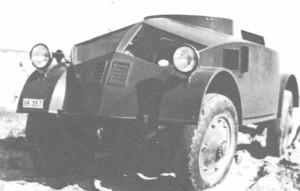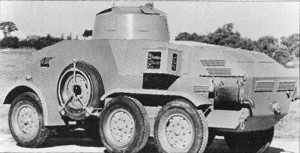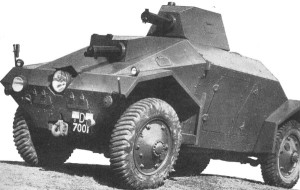Straussler Armored Car – AC1, AC2 and AC3
Straussler’s first vehicle design emerged in May 1931. It was a dual-purpose scout car/ tractor chassis, which had four-wheel drive and four-wheel steering. The suspension was independent with swing axles and the vehicle could be driven in either direction by swivelling an upright ship’s-style steering wheel. The engine was a Ford 3.3-litre L-head with adaptations to the fan and the water outlet, while the gearbox was a four-speed unit from a Ford AA truck but set up so that ail ratios could be used in both directions. The wheels were also from the Ford AA and had Dunlop Trackgrip 30×5 tyres.
The vehicle was sent for testing at the Mechanical Warfare Experimental Establishment (MWEE) in Farnborough on 31 May 1932, where it showed potential in its cross-country performance but was hard to control on the road, probably due to its unconventional steering column.
In 1933, Straussler set up a new company, Straussler Mechanization Ltd, with a factory at Harlequin Avenue in Brentford. The first Straussler armoured car prototype, the AC1, was produced In 1933 and featured four-wheel drive and steering (a lever beside the driver enabled the selection of four-wheel, front-wheel or rear-wheel drive) with independent suspension on all four wheels.
 It was actually manufactured by Manfred Weiss of Csepel, in Hungary. Indeed, on many occasions Straussler had difficulty getting prototypes built and was forced to have them manufactured in his native country and transported over to Britain for testing and marketing. The AC1 ‘s performance potential was of interest to the RAF and was duly tested by the MWEE in June 1933 on behalf of the Air Ministry, but failed to live up to expectations and was not taken up. One reason given was that the vehicle produced wheel spin on a slope of 1:2.
It was actually manufactured by Manfred Weiss of Csepel, in Hungary. Indeed, on many occasions Straussler had difficulty getting prototypes built and was forced to have them manufactured in his native country and transported over to Britain for testing and marketing. The AC1 ‘s performance potential was of interest to the RAF and was duly tested by the MWEE in June 1933 on behalf of the Air Ministry, but failed to live up to expectations and was not taken up. One reason given was that the vehicle produced wheel spin on a slope of 1:2.
Trials the following year on an improved AC1 by the Mechanised Experimental Establishment (MEE), as the MWEE became in 1934, produced another rejection. The capacity of the engine had been altered from 3.3 litres to 3.6 litres, resulting in an increase in power from 75bhp to 110bhp, but in order to achieve the higher rating, the engine required a compression ratio of 7.5:1, which in turn meant that it had to run on special fuel.
Although the vehicle performed excellently on and off-road and was able to traverse very steep loose-surfaced Inclines, the Mechanisation Board Report stated that: ‘A power output of this order in so small an engine in an armoured fighting vehicle appears to be a proposition which is hardly practicable’. This proved to be the case, as one of the pistons and the big end collapsed during the trial, and therefore no further action was taken in respect to the vehicle.
 In 1935, Straussler produced an improved version known, logically enough, as the AC2. The radiator had been changed from a square-type with an ordinary fan to a circular-type with a turbine fan cooler, and a second steering wheel and pedals were introduced at the rear to make better use of the four-wheel steering.
In 1935, Straussler produced an improved version known, logically enough, as the AC2. The radiator had been changed from a square-type with an ordinary fan to a circular-type with a turbine fan cooler, and a second steering wheel and pedals were introduced at the rear to make better use of the four-wheel steering.
Two prototypes where produced by Manfred Weiss in Hungry. In the same year, the RAF trialled one of the AC2s in a desert environment over a route between Port Said and Baghdad with positive results, but it had a problem with the handbrake which, if applied on the move, had disastrous consequences for the differential. The other AC2 remained at the factory and was used as a test bed for foreign offerings.
Amongst Straussler’s interesting joint ventures was that with the Alvis company following the incorporation of Alvis-Straussler Ltd on 13 July 1936. This combination of Alvis engineering and Straussler ingenuity produced the AC3, which used a chassis imported from Manfred Weiss powered by a 120bhp Alvis 4.3-litre engine. With a fuel capacity of 45 gallons (205 l), the AC3 had a theoretical, but impressive, range In the region of 375 miles (600km).
The RAF ordered 12 AC3s in 1937 which were duly shipped out to the Middle East for use as civil defence vehicles and given the designation of ‘Car, Armoured, Alvis-Straussler, Type A’. Most, if not all, were based in Aden.
 The Dutch were also interested in the AC3 for service in Java but had different requirements so the design was altered to suit. The resulting AC3D, as it was known, had a crew of four with a water-cooled Browning .50cal in the turret and a second carried for anti-aircraft defence. However, it lacked a radio set. Interest was also shown in the AC3 by the Portuguese who tested it in 1937 and subsequently ordered three of the AC3D variant.
The Dutch were also interested in the AC3 for service in Java but had different requirements so the design was altered to suit. The resulting AC3D, as it was known, had a crew of four with a water-cooled Browning .50cal in the turret and a second carried for anti-aircraft defence. However, it lacked a radio set. Interest was also shown in the AC3 by the Portuguese who tested it in 1937 and subsequently ordered three of the AC3D variant.
Between July 1937 and October 1938, one of the cars built for the RAF was trialled by the MEE ‘to ascertain the performance’. Although it was considered largely satisfactory, it was deemed as ‘not really fast enough to be classed as an armoured car and not well enough armoured or equipped to function as a wheeled tank’.
During 1938, Alvis-Straussler offered the War Office a wholly Straussler-designed Manfred Weiss-built prototype, the LAC (for light armoured car). The vehicle was very unconventional, with two Ford 3.6-litre, 85bhp V8 engines, one to power the right-hand wheels, the other to power the left-hand wheels, each independent of the other but with a common gear-change linkage and throttle; the vehicle could also be run on one engine If the other failed.
The MEE tested the machine on behalf of the India Office in January 1938 and found it to have distinct possibilities as a gun tractor, but that its cooling system was inadequate. There was also a tendency when driven on one engine for the vehicle to ‘creep’ towards the other side. After some modifications the LAC was retested on 4 April but was again rejected on the grounds of inadequate cooling.
Another similar vehicle was envisaged by Straussler in 1938. Known as the Multi-Purpose Chassis, Model PV-W, it would have been powered by two Lincoln V12 engines had it ever been built.
 Late in 1938, the Hungarian Ministry of Defence ordered eight armoured cars based on the AC2 from Manfred Weiss. As a result, the first Csaba, designated 39M, appeared in June 1939. In January 1940, the eight mild-steel vehicles performed satisfactorily during the annexation of Transylvania and 93 armoured versions were ordered, 12 of which were command vehicles. There was a third order for 70 armoured cars but there is no confirmation as to whether they were ever manufactured.
Late in 1938, the Hungarian Ministry of Defence ordered eight armoured cars based on the AC2 from Manfred Weiss. As a result, the first Csaba, designated 39M, appeared in June 1939. In January 1940, the eight mild-steel vehicles performed satisfactorily during the annexation of Transylvania and 93 armoured versions were ordered, 12 of which were command vehicles. There was a third order for 70 armoured cars but there is no confirmation as to whether they were ever manufactured.
The command vehicle, the 40M, was fitted with a smaller turret and a frame-type radio mast, and whereas the radio in the 39M was an R-4 unit, the 40M had both an R-4T and an R-4. Both variants were powered by a 90bhp German-built Ford eight-cylinder engine which gave the 39M a maximum speed of 40mph (65km/h) against the 40M’s 44mph (70km/h). Both vehicles had a six-speed gearbox and forward/reverse transfer box, and featured two or four-wheel steering plus Independent suspension.
The 39M was armed with a 20mm main gun plus two 8mm machine guns. The 40M was lightly armed in comparison with only a single 8mm machine gun. Both vehicles had an operating crew of four and weighed a tad under six tons.
In 1943, two vehicles were produced for the Hungarian Police which appear to have been of the same design as the 40M Csaba but with no weapon mounted in the turret. They were painted dark blue and bore the registrations RR511 and RR512. In March 1943, the Hungarian Army ordered 50 Csabas but it appears that this order was not fulfilled, possibly due to the Manfred Weiss factory being required to switch production away from armoured cars.
There appears to be no trace of the Hungarian armoured cars after WW2, and it is presumed that most were destroyed by the Russian Army. The British AC3s soon ran out of spare parts after the factory in Hungary stopped supplying Alvis-Straussler, while the Dutch AC3Ds, which the Japanese had commandeered, were taken over by Indonesian forces and used for a number of years. At least one was still in working order in the sixties as Alvis was still receiving requests for parts! One of the Portuguese AC3Ds came up for sale in 1988, and was sold to a private collector.
Straussler went on to design all manner of things, most related to amphibious, off-road and military vehicles. However, it is the flotation screen that gave rise to the ‘swimming tank’ -notably the duplex-drive Sherman – with which he is most associated. Text by Sheldon Michael Rogers – The Tank Museum
